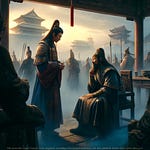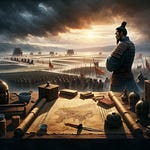Sun Tzu said: Earth comprises distances, great and small; danger and security; open ground and narrow passes; the chances of life and death.
The key to combat relies on marching; it is a crucial part of battle, perhaps even more important than the exchange of fire. Many people think that combat only starts when the firing begins, but in reality, the outcome is often determined by then. Marching involves appearing at the right time and place with the right forces, which is decisive in determining victory. The quality of the marching route depends on the commander’s familiarity with the terrain. Only by understanding the area's distances, terrain risks, battlefield size, and geographical conditions can decisions be made on whether to take a direct route or a detour, use cavalry or infantry, where to deploy forces, where to hold strategic passes, where soldiers can fight to their utmost, and where they might easily flee. Many famous battles in history have been influenced by the terrain on which they were fought, including the Battle of Thermopylae and the Battle of Stalingrad.
The Battle of Thermopylae, which took place in 480 BC, was a pivotal battle in the Greco-Persian Wars and holds significant historical and military importance in Western history. The battle arose from Persian King Xerxes I's campaign against ancient Greece to avenge the defeat at Marathon, amassing a large army. Facing this threat, the Greek city-states of Athens and Sparta united under a Spartan-led coalition. The battle's terrain, a narrow pass at Thermopylae flanked by the sea on one side and steep mountains on the other, played a critical role in the conflict. This complex geography, with mountains, rivers, and gorges, greatly hindered Persian cavalry. The Greek forces, led by Spartan King Leonidas I and numbering around 7,000, held their ground in this pass against a vastly superior Persian force for three days, utilizing the terrain to their advantage. Despite ultimately being surrounded and annihilated, their sacrifice bought precious time for other city-states like Athens, setting the stage for Greek victories later on. Though the Persians eventually captured Thermopylae, it came at a heavy cost, highlighting the significant impact of terrain on battle outcomes and marking a legendary feat in Western military history, showcasing Spartan bravery and combat prowess.
The Battle of Stalingrad, from July 17, 1942, to February 2, 1943, was one of the most famous battles of World War II, known for its massive scale and heavy casualties. It also marked a turning point in the war. The terrain played a crucial role, with Stalingrad located on the banks of the Volga River, making it difficult for the German army to completely surround the city. The initial phase saw a major bombing by the German air force, followed by a rapid breakthrough of Soviet defenses. However, the urban layout of Stalingrad turned to the Soviets' advantage, with narrow streets limiting German tank mobility and sturdy buildings providing defensive positions for Soviet forces. The battle eventually turned to street fighting, stalling the German advance. In November 1942, the Soviet counteroffensive exploited weak links guarded by Axis allied forces, breaking through at the Volga's eastern bank and northwest of Stalingrad, encircling the German 6th Army and other Axis forces inside the city. The Germans surrendered due to harsh winter conditions, disease, and resource depletion. The Soviet victory at Stalingrad was not just due to their resilience and tactics but also their effective use of the terrain, turning every building and street into a defensive battle, crippling the German advantage. This victory halted German advances on the Eastern Front and shifted the war's momentum to the Soviets, marking a critical turning point in World War II.










Share this post